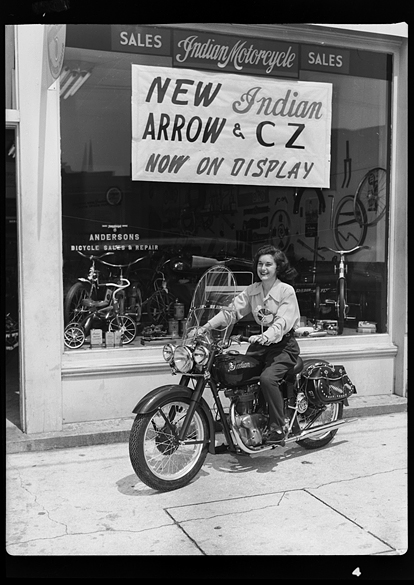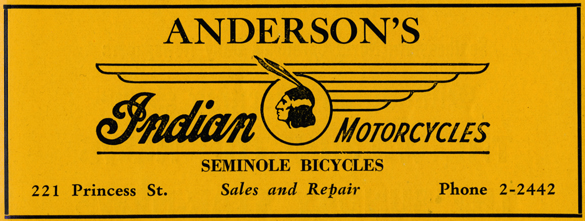Serendipity strikes again! While going through negatives of UNC students from the 1940s, I saw an image of a woman sitting on an Indian motorcycle that hadn’t been digitized and just cried out, “Scan me!” It’s today’s featured photograph from the Hugh Morton collection.
 The rider in this portrait (or advertisement?) is probably not a UNC student because I tracked downed Anderson’s bicycle shop in Wilmington city directories. Would anyone like to try and identify the model and year of the motorcycle? Bonus points for the rider, although I suspect she may be a model rather that the owner, but you never know. Here are some clues to sleuth:
The rider in this portrait (or advertisement?) is probably not a UNC student because I tracked downed Anderson’s bicycle shop in Wilmington city directories. Would anyone like to try and identify the model and year of the motorcycle? Bonus points for the rider, although I suspect she may be a model rather that the owner, but you never know. Here are some clues to sleuth:
- According to Wikipedia, production of traditional Indians was extremely limited in 1949, and no 1949 Chiefs are known to exist. Indian halted the manufacture of all products in 1953.
- In Hill’s Wilmington city directory for 1948-49, Anderson’s advertisement in the “Classified Buyer’s Guide” featured the Indian Motorcycles brand, which was not mentioned in the store’s ad in the previous directory for 1947.
- Anderson’s address in the 1948-1949 directory was 221 Princess Street, which was just down and across the street from the offices of Hugh MacRae & Company and The Linville Company at 214 Princess Street. In the next city directory available to me, 1952, there is no Anderson Bike Shop listed, and 221 Princess is occupied by the offices of The Linville Company, and Hugh MacRae and Company. In the 1947 directory, neither the Anderson Bike shop advertisement nor its alphabetical listing mention Indian motorcycles.


Interesting to see not only bicycles but also tricycles in the Anderson’s window. I wonder how long it took for bike and motorcycle dealerships to go their separate ways….
The Indian marque has changed hands frequently over the past half century, more than once via bankruptcy. From 2006 until earlier this year, when the company was sold once more and operations relocated to Iowa, Indians were manufactured in Kings Mountain.
Thanks, Lew! I didn’t read down the company’s historical timeline webpage far enough to notice the North Carolina connection.
What a great image. Is it possible to buy a print?
Glad you enjoyed it, Joe. Yes you may purchase a print. Send your request, including print size, to wilsonlibrary . . . at . . . unc . . . dot . . . edu (without all that extraneous stuff designed to avoid spam). Be sure to refer to this blog post because the scan has not yet been added to the online collection. Thanks for visiting the blog!
I’m not an expert on motorcycles at all. But I’m going to take shot here. 1948 Indian Super scout. I may be a mile off but after doing some research it’s the best I could come up with.
It seems to be the 1949 Indian Model 249 Super Scout, although the front transparent panel seems to be missing. Maybe it’s an addon attachment to the bike.
The motorcycle is a model 149 Indian Arrow with all the accessory upgrades installed…the wind shield, the crash bars, light bar across the front and the saddlebages. This appears to be an early promo shot. The CZs at 125ccs and the Arrows at 220ccs were targeted towards women as easy to learn to ride and light-weight so they were easy to handle. There were 3 versions of the Arrow, this one does not have additional lettering under the “Indian” on the tank-this tells us it is a base model arrow that the dealer put all the factory accessories on as a sales strategy along with a pretty girl for good measure.
Correction to previous comment…no crash bars on this bike.
I love this shot! I was wondering if I may use this image for a painting?
It would be greatly appreciated and I would name the source.
Chrissy
Wow .. motors are very rare and classic. whether it is still there?
my son is currently doing a report for high school on early motorcycles. I ride myself, and it was pretty cool for him to visit this page to see what they looked like in the early years. immediately he asked why are the tires so thin like bicycle tires. lol kids…. well thanks for sharing
I would love to have that portrait hanging over my shop. I think I will start collecting antique bike advertisements. 🙂
That could be a photo of Jane Russell
Great image! Great bike! Indian still makes quality bikes to this day. I like that Polaris has picked them up and invested some money into the brand.
The image shows an Indian Arrow. Jane Russell had one, also. The 249 Scout had plunger rear suspension; the Arrow is a hardtail.
I found small illustrated advertisements for Anderson’s Bike Shop as an authorized Indian motorcycle dealer in the Wilmington Morning Star beginning August 3, 1947 that ran throughout the remainder of the year. On October 11, the day before motorcycle races at Legion Stadium, Anderson’s Sporting Goods store ran a larger illustrated ad encouraging people to “come in and see the new Indian motorcycles” after their afternoon of “real spine-tingling enjoyment” at the races. A separate, larger ad on the same page for the races themselves noted that the Wilmington Motorcycle Club sponsored and the American Motorcycle Association sanctioned the three-star event.
The “model” on the Indian is my mother. Her name is Jennie (Jinx) Branch Thompson and she was the bookkeeper for Anderson’s. The photo was taken for the Azalea Parade that year(1948 or 1949). She actually rode the bike in the parade advertising for Anderson’s. I still have the original photo that she was given that year.
That’s terrific Ms. Masters . . . Thank you very much!! I’ve really been hoping someone who knew would let us know.